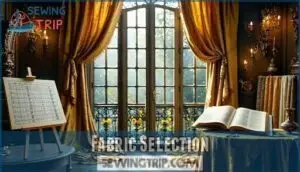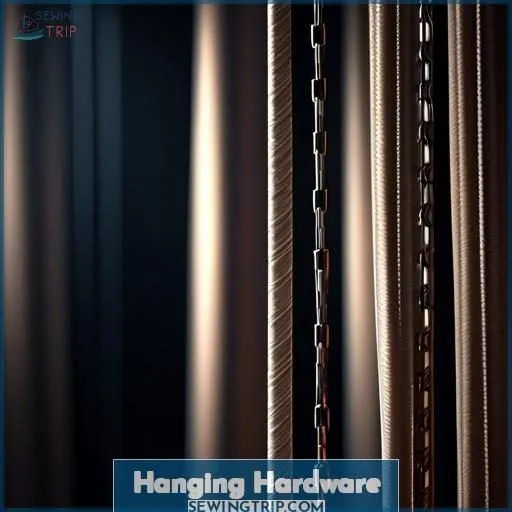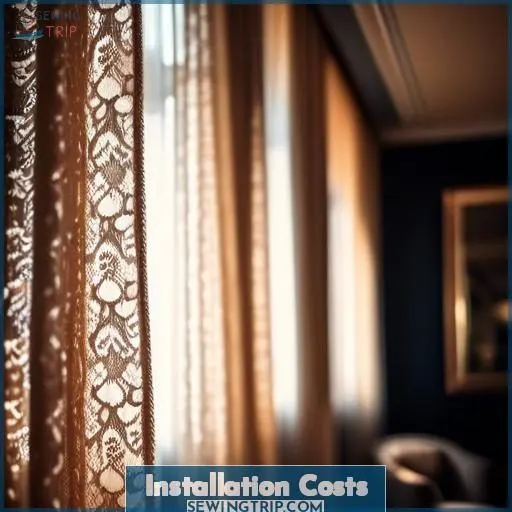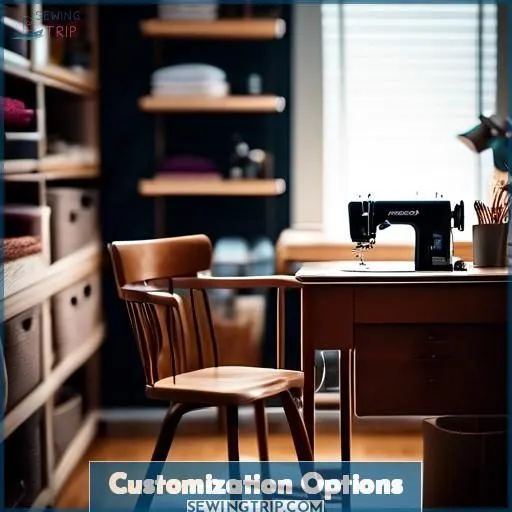This site is supported by our readers. We may earn a commission, at no cost to you, if you purchase through links.
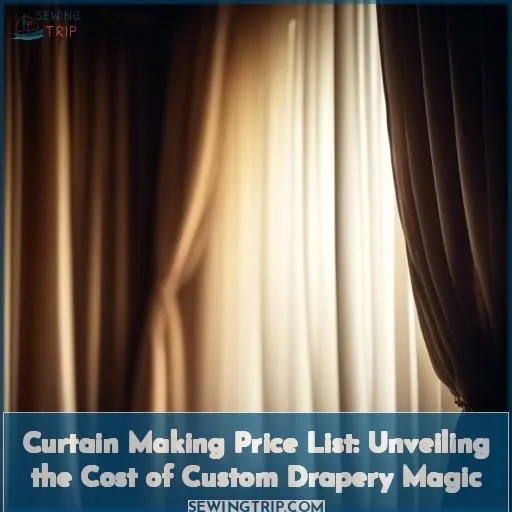
When crafting your perfect curtains, the pricing can be an intricate dance of fabric, hardware, and installation. Start with the base price for the curtain fabric, then consider add-ons like lining, pleats, and custom sizing.
Hanging hardware, from rods to finials, also impacts the overall cost. Installation, whether DIY or professional, is another key factor – labor, materials, and location can all influence the price tag.
With so many customization options, from pocket styles to lengths, the possibilities are endless. Dive deeper to uncover the full curtain making price list and bring your vision to life.
Table Of Contents
Key Takeaways
- The cost of custom drapery can vary based on factors such as physical requirements, external consultations, personal sewing methods, and additional considerations.
- The base price for custom curtains serves as the foundation, while add-ons like lining, pleats, and custom sizing can tailor the curtains to perfection.
- Hanging hardware, such as rods, finials, holdbacks, and valances, also impacts the overall cost.
- Installation costs can fluctuate based on labor fees, expert assistance, and do-it-yourself possibilities.
Curtain Making Price List

Starting a custom curtain project can be an exciting experience, but understanding the price list is vital. The cost of custom drapery can vary, with factors such as physical requirements, external consultations, personal sewing methods, and additional considerations affecting the price.
Home decor projects can be relatively straightforward, but the complexity and materials used can have a substantial impact on the cost. Professional services, DIY options, and customization choices like pocket styles, lengths, and installation methods also play a role in determining the final price.
Fabric Selection
In the realm of curtain creation, the fabric selection process is paramount. The base price serves as the cornerstone, while enhancements grant you the ability to tailor your curtains to perfection, ultimately sculpting the final cost of your desired drapery.
Base Price
Venturing into the realm of bespoke curtain creation, the foundation fabric establishes the setting. It’s your canvas, where aspirations of chromatic palettes, tactile diversities, and motifs are realized.
This preliminary selection in our pricing guide is paramount, shaping both aesthetics and financial considerations.
Selecting tailored curtains entails exploring lining alternatives and meticulous craftsmanship, guaranteeing that your haven manifests your refined taste and yearning for security.
Add-Ons
Discovering the perfect drapery for your home is an exciting journey, and with the right add-ons, you can customize your curtains to your heart’s content.
From lining options and interlining variations to pleat styles and custom sizing, the choice is yours. You can opt for eyelet headings, wave headings, or contrast edges and borders, all while selecting the perfect fabric for your space.
Tape headed options are also available, adding a touch of sophistication to your curtains. Remember, the more customized your curtains, the more the price will vary.
Total Price
As you explore the curtain making price list in more detail, you’ll notice that the final cost is a combination of the base price and any additional features you select. The base price remains unchanged, but the add-ons can differ based on your preferences for customization.
The total price is displayed on the product page and is adjusted when you change the quantity in your cart.
Remember to utilize any discount codes to lower the cost of your purchase.
Hanging Hardware
Curtain rods, finials, holdbacks, and valances are the essential pieces of hardware that bring your custom curtains to life. Selecting the right hanging hardware can accentuate the look and feel of your space, so don’t overlook this important step in your curtain-making journey.
Rods
After selecting the perfect fabric, it’s time to talk rods. Your drapery’s backbone, these rods must withstand the curtain weight and complement your chosen style.
Opt for a pole width that balances the drop length, ensuring a harmonious flow. Remember, hardware quality can make or break the installation complexity.
Choose wisely, as the right rods elevate your window coverings from mere fabric to artful drapery.
Finials
After selecting the perfect rods, it’s time to cap off your custom drapery with finials that reflect your style. These little gems come in a variety of materials, sizes, and designs, adding a final flourish to your window dressing.
Whether you’re after a splash of color or a touch of elegance, finials are the crowning glory on your curtain making masterpiece.
Holdbacks
Holdbacks are the unsung heroes of your curtain game, ensuring your drapes stay in place and add a touch of elegance to your windows. Here are three types of holdbacks to contemplate:
- Pinch Pleat Holdbacks: These are perfect for curtains with pinch pleats, as they secure the fabric in place without damaging the pleats.
- Pencil Pleat Holdbacks: Ideal for curtains with pencil pleats, these holdbacks slide along the rod, allowing you to adjust the drapery to your desired length.
- Triple Pinch Pleat Holdbacks: For curtains with triple pinch pleats, these holdbacks secure the fabric at the desired length while maintaining the pleats’ shape.
Holdbacks come in various materials and styles, so choose the ones that best complement your window treatments. Remember, holdbacks aren’t just functional; they also add a decorative touch to your curtains.
Valances
Valances are the decorative pieces that top off your curtains, adding a touch of elegance and sophistication to your windows. They come in various fabric options, header styles, lining choices, and embellishments, allowing you to customize them according to your preferences.
Decorative details like fringes, tassels, and beading can elevate the look of your valances. Lined and interlined valances offer a more luxurious feel, while day rate and decorator fabrics can add a touch of luxury.
The length of your valance can also be customized to match the length of your curtain.
Installation Costs
Regarding curtain installation, you must account for labor fees, expert assistance, and do-it-yourself possibilities. The installation cost can fluctuate dramatically based on your region, the complexity of the endeavor, and the materials employed. Therefore, obtaining estimates from multiple sources before settling on a particular approach is prudent.
Labor
Regarding labor costs for custom drapery, there are several factors to keep in mind. Labor prices may vary depending on the craftsperson’s skill level, the materials used, and the project’s complexity.
For instance, a pencil pleat heading on a 130cm pole width with 2 drops might cost around £165, while a lined and interlined curtain with the same heading and pole width could cost £189.
Time constraints and the need for precision can also impact labor costs. A half-day rate for a skilled craftsperson might be £200, while a full-day rate could be £400.
Note that these prices are only a starting point and may vary based on your specific project and location.
Professional Services
As you progress further into the domain of custom drapery, it’s time to explore the sphere of professional services. These are the specialists who can materialize your vision, guaranteeing that your window treatments aren’t merely aesthetically pleasing but also practical and long-lasting. Here’s an overview of what you can anticipate when you opt to collaborate with a professional service:
- Customization Options: Professional services provide a broad range of customization options, encompassing the fabric type and pleat style. They can assist you in selecting the ideal drapes for your space, considering elements such as light control, privacy, and the overall ambiance of your room.
- Fabric Management: Handling large and heavy fabrics can be physically demanding, and professionals possess the appropriate equipment and infrastructure to make the process safe and efficient. They can withstand the stress that heavy fabrics impose on home sewing machines, ensuring the optimal condition of your machine.
- Installation Methods: Professionals are adept in diverse installation methods, including rod pocket, grommet, back tab, pinch pleat, and traverse rod. They can guide you on the most suitable method for your specific requirements and preferences.
- Location-Specific Considerations: Depending on your location, there may be unique considerations for your window treatments. For instance, in New York City, you might need to account for high humidity levels, while in Los Angeles, you might be concerned about sun damage. Professionals can assist you in navigating these challenges.
- Labor Costs: The labor cost for professional services can vary based on the project’s complexity and the materials utilized. You can expect to pay anywhere from $100 to $200 per panel for basic labor, with higher costs for more intricate designs or custom work.
- Workroom Pricing: Custom workrooms typically charge a fee for supplying your own fabric, but their prices are usually lower than those of professional services. They may also have restrictions on who they work for, only doing work for the homeowner and immediate family.
DIY Options
Delving into self-made curtain crafting? It’s like setting off on an adventure in your home decor atelier. Fabric choice transforms into your guide, directing you through an ocean of white muslin and durable canvas.
With DIY methods, the financial contrast to professional services is stark, making project planning and time commitment your compass and excavation tool.
Whether you’re creating flat cushioned straight or sculpted masterpieces, the fulfillment of revealing your bespoke drapery artistry is unmatched.
Customization Options
Regarding curtain customization, the choices are limitless. From pocket designs and sizes to installation techniques adapted to your surroundings, the options empower you to craft a truly bespoke aesthetic that enhances your environment.
Pocket Styles
Regarding pocket styles for your personalized drapery, there are numerous choices to take into account. The selection is contingent upon factors such as fabric thickness, lining possibilities, header styles, grommet dimensions, and rod compatibility. Here’s a breakdown of the most prevalent pocket styles:
Rod Pocket: This is the most basic and widely used header style. A pocket channel is stitched into the curtain panel’s apex, and curtains are hung by inserting a curtain rod into this channel.
Grommet: Grommets are diminutive metal or plastic rings stitched into the curtain panel’s apex. The rod is threaded through these rings, and they’re frequently employed for sheer or lightweight fabrics.
Back Tab: Instead of a continuous pocket, back tab curtains possess separate tabs on the back. This contributes to a more uniform pattern in the folds and is often deemed more refined in appearance than a traditional rod pocket.
Pinch Pleat: This style incorporates pleats that are stitched into the curtain panel’s apex. The rod is threaded through these pleats, and they’re often utilized for heavier fabrics.
Box Pleat Yolked and Piped: This style boasts a box pleat with a yoke at its apex and piping around its borders. It’s frequently used for a more formal or traditional ambiance.
Custom Length: Certain drapery panels are available in customized lengths, enabling you to select the ideal fit for your window.
Lengths
Regarding the length of your curtains, you have multiple choices. The typical lengths encompass:
Sill length, which descends nearly to the windowsill.
Apron length, which extends slightly beyond the bottom of the window casing.
Floor length, which ceases two inches from the floor.
Trouser length, which touches the floor.
Puddle length, which gathers on the floor.
If none of these conventional lengths meet your requirements, you can select a tailored length that more aptly aligns with your window. Bear in mind that the length of your curtains can substantially influence the overall ambiance of your space, so it’s crucial to pick the appropriate one for your abode.
Installation Methods
Installation techniques play a pivotal role in the overall aesthetic and practicality of your custom curtains. The selection of installation method can influence the ease of use, the appearance of the curtains, and even the energy savings of your window treatments. Here are the four primary installation techniques for custom drapes:
- Grommet Curtains: These curtains feature rings embedded in their headers, enabling the curtain pole to pass through and create distinct pleats. Grommet curtains are perfect for modern or trendy decor styles, as they provide a sleek finish and enhanced durability over time.
- Rod Pocket Curtains: These curtains have a sewn-in pocket that facilitates effortless rod insertion, creating graceful gathers along the rod. The rod pocket method is a classic choice for a traditional look.
- Back Tab Curtains: With tabs discreetly sewn onto the back of the header, the back tab method presents a custom-made appearance. This method allows for a clean and elegant drape, with pleats forming at each tab.
- Pinch Pleat Curtains: These curtains have a structured and formal look, with curtain hooks or rings facilitating easy hanging and pleat formation. Pinch pleat curtains are suitable for those seeking a sophisticated ambiance.
When considering installation techniques, it’s imperative to select the one that best aligns with your desired aesthetic and practical requirements. Additionally, the choice of installation method may impact the labor costs associated with the installation process. Professional services may charge more for certain methods, such as back tab or pinch pleat, due to the additional time and expertise required for installation.
Location-Specific Considerations
Location plays a significant role in the cost of custom drapery. The cost of labor and materials can vary depending on the region, with labor costs typically being higher in urban areas like New York City and San Francisco compared to more rural locations like Los Angeles or Chicago.
Additionally, the availability of local workrooms and their pricing may also differ based on location. Customers should consider these location-specific factors when budgeting for their custom drapery project.
Frequently Asked Questions (FAQs)
How much does it cost to customize the length of the drapes?
Tailoring custom-cut curtains caters to your cozy comfort! Select from a myriad of snug sill-skimming, floor-sweeping, or puddle-puddling lengths – the impeccable fit for your fabulous feathered nest. Flexible pricing guarantees your vision’s manifestation, devoid of stress.
What is the average cost of a custom curtain rod with all necessary hardware?
The cost of a custom curtain rod with all necessary hardware can range from $100 to $500, depending on the size, material, and complexity of the installation. Your ideal setup is just a phone call away!
How much does it typically cost to add a valance to a custom curtain set?
Adding a valance to your custom curtains typically costs around $40-$90 per width. The price can vary based on the complexity of the valance design and the materials used. This extra touch really elevates the look of your space.
What is the price range for custom cornices made from different materials?
Ah, custom cornices – the architectural icing on your window’s decor cake! Expect to pay anywhere from $200 to $1000, depending on the materials used and the complexity of the design. Elevate your space with a custom-crafted cornice that fits your style and budget.
How much does it cost to add a custom fabric to an existing curtain design?
Adding your own custom fabric can really elevate your curtain design, and the typical cost is around $40-$60 per panel. Just let your home decor workroom know the fabric you have in mind, and they’ll happily create a quote.
Conclusion
When all’s said and done, your curtain making price list is the roadmap to your dream drapery. Explore the fabric, hardware, and installation details to uncover the full curtain making cost. By considering the curtain making price list, you’ll be able to bring your vision to life and transform your space with the perfect custom curtains.
The possibilities are endless, so don’t be afraid to explore all the customization options that fit your budget and style.

